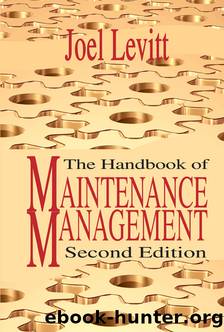The Handbook of Maintenance Management Second Edition by Joel Levitt

Author:Joel Levitt
Language: eng
Format: epub
Publisher: Industrial Press
28
PM Task List Development
The task list is the heart of the PM system. It reminds the inspector what to do, what to use, what to look for, how to do it, and when to do it. In its highest form it represents the accumulated knowledge of the manufacturer, the dealer, skilled mechanics and engineers, regarding the avoidance of failure
Task lists are designed by manufacturers, skilled mechanics, engineers, contractors, insurance companies, governmental agencies, trade associations, equipment distributors, consultants, and sometimes by large customers.
All task list items are designed to perform one of two functions. The two functions are the core of all PM thought and they are designed either to extend the life of an asset or detect when the asset has begun its descent into breakdown (before it actually breaks). It is also the assumption of the designer of PM tasks that when a problem is detected during inspection, scanning, taking readings, etc. that the maintenance system will respond with a corrective action.
Activities you might find on a task list:
Life extension Detection
Clean Inspect
Empty Scan
Tighten Smell for...
Secure Take readings
Component replacement Measure
Lubricate Take sample for analysis
Refill Look at parts
Top-off Operate
Perform short repair Jog
Review history
Write-up deficiency
Interview operator
Tasks are designed to prevent three types of failures:
•Dangerous failures injurious to the public, employees or to the environment
•Expensive failures including downtime, large breakdowns
•Frequent failures that happen continually and are disruptive to the work environment
In RCM (Reliability Centered Maintenance), breakdowns are divided into three levels or grades depending on the consequences of the breakdown. In fact, to paraphrase John Moubray in RCM II, the problem is not failure at all, it is the consequences of failure:
1.Breakdowns where the consequences are loss of life or environmental contamination such as a boiler safety valve or the rupture of a tank of volatile chemicals.
2.Failures where the consequences are operational downtime such as loss of cooling water to a data center or the breakage of the chain in an auto assembly line.
3.Failures where the consequences are repair costs such as the breakdown of one of several milling machines in a machine shop.
Each task (line item) should be considered carefully before inclusion because inclusion creates another cost for the long term. The quick way to evaluate task economics is to relate the task cost per year to the avoided cost of the breakdown. In category 2 or 3, economic analysis is the way to determine if a task should be included. In category 1, the task must be included or the asset re-engineered to remove the threat of failure.
For categories 2 and 3
Breakdown costs:
(Probability of failure in 1 year) * (cost of downtime + cost of repair) <
PM Costs:
(Cost per task * # services per year) +
(New Probability of failure in 1 year * (cost of downtime + cost of repair))
Example
Breakdown costs
Compressor breaks down once every 2 years (50% probability each year) under the existing bust’n’fix (reactive maintenance) plan. It costs $15,000 each time to repair and causes $60,000 of downtime.
0.5 * ($60,000 + $15,000) = $37,500 per year
PM Costs
Service compressor 12
Download
This site does not store any files on its server. We only index and link to content provided by other sites. Please contact the content providers to delete copyright contents if any and email us, we'll remove relevant links or contents immediately.
What's Done in Darkness by Kayla Perrin(25501)
Shot Through the Heart: DI Grace Fisher 2 by Isabelle Grey(18220)
Shot Through the Heart by Mercy Celeste(18160)
The Fifty Shades Trilogy & Grey by E L James(17777)
The 3rd Cycle of the Betrayed Series Collection: Extremely Controversial Historical Thrillers (Betrayed Series Boxed set) by McCray Carolyn(13189)
The Subtle Art of Not Giving a F*ck by Mark Manson(12913)
Scorched Earth by Nick Kyme(11833)
Stepbrother Stories 2 - 21 Taboo Story Collection (Brother Sister Stepbrother Stepsister Taboo Pseudo Incest Family Virgin Creampie Pregnant Forced Pregnancy Breeding) by Roxi Harding(11040)
Drei Generationen auf dem Jakobsweg by Stein Pia(10217)
Suna by Ziefle Pia(10186)
Scythe by Neal Shusterman(9263)
International Relations from the Global South; Worlds of Difference; First Edition by Arlene B. Tickner & Karen Smith(8609)
Successful Proposal Strategies for Small Businesses: Using Knowledge Management ot Win Govenment, Private Sector, and International Contracts 3rd Edition by Robert Frey(8419)
This is Going to Hurt by Adam Kay(7696)
Dirty Filthy Fix: A Fixed Trilogy Novella by Laurelin Paige(6453)
He Loves Me...KNOT by RC Boldt(5805)
How to Make Love to a Negro Without Getting Tired by Dany LaFerrière(5378)
Interdimensional Brothel by F4U(5305)
Thankful For Her by Alexa Riley(5162)
